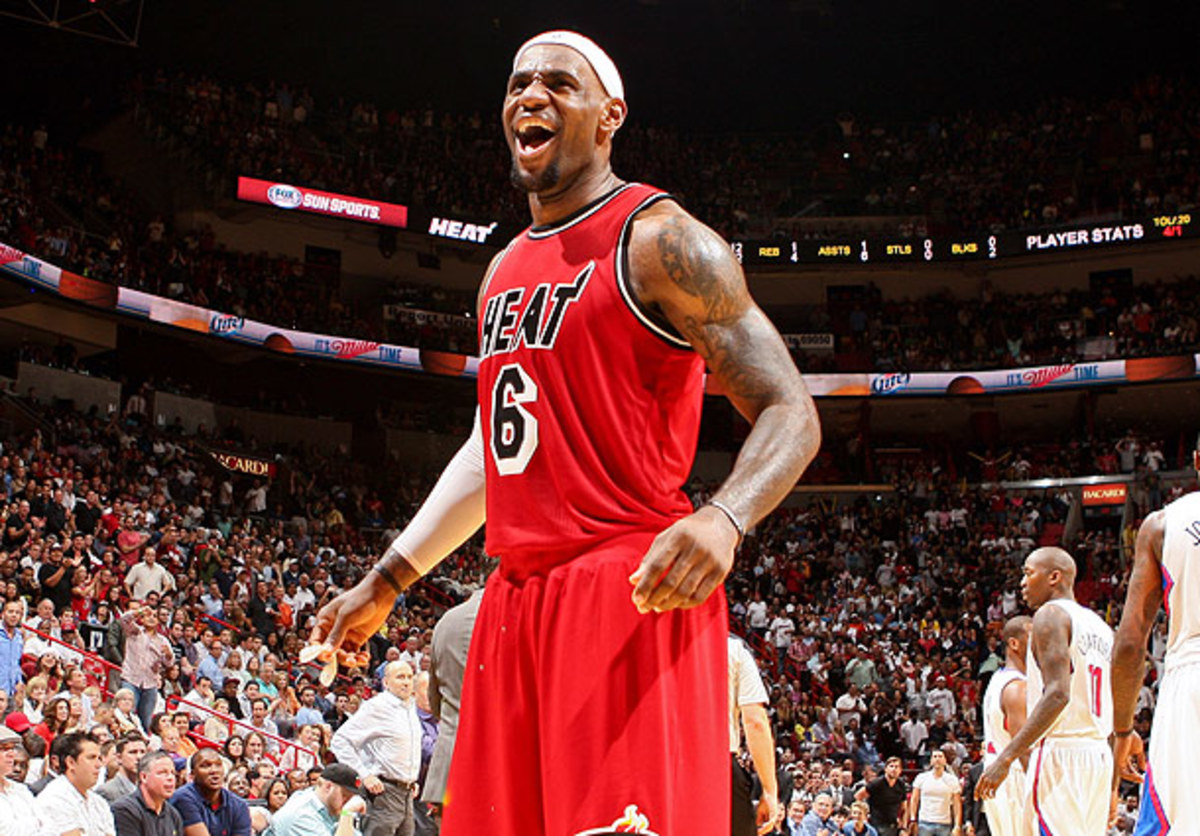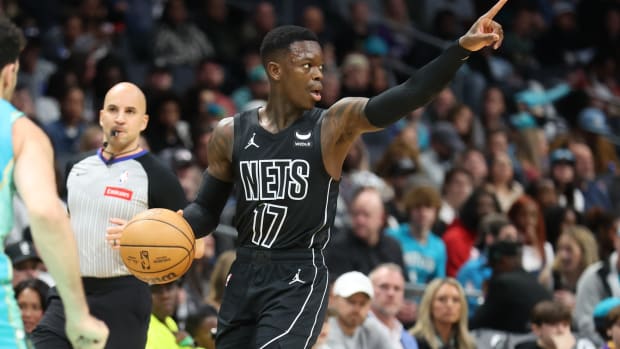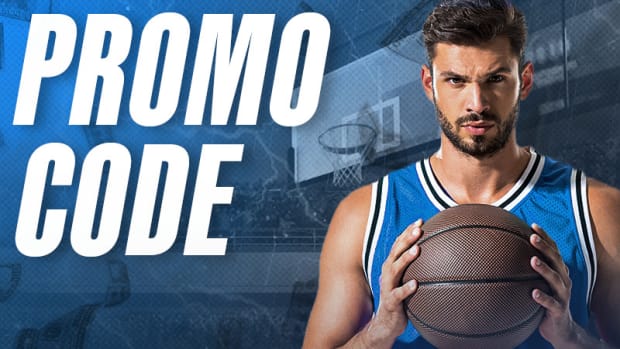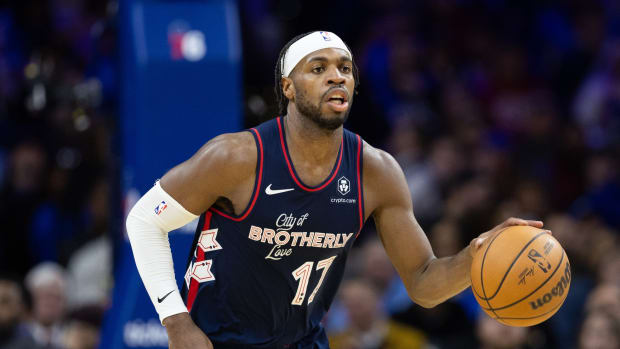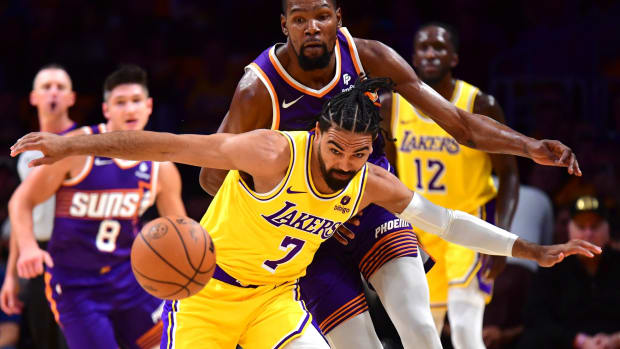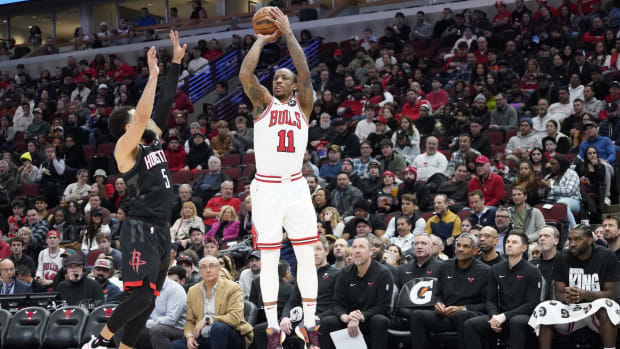The Fundamentals: LeBron James taking his game to staggering new heights
Over his last five games, LeBron James has averaged 31 points and 6 assists on 71.4 percent shooting. (Issac Baldizon/NBAE via Getty Images)
By Rob Mahoney
The play of LeBron James has long been one of the most compelling aspects of the NBA, but lately the experience of watching the world's best basketball player has taken on an entirely new significance. Outrageously efficient performance has become so predictable for James that every appearance is now appointment viewing.
By now, most NBA fans have caught wind of James' most recent exploits: a five-game stretch in which he topped 30 points on every occasion, anchored five consecutive Miami victories and posted an absurd 71.4 field goal percentage. Trim away some of James' misses at the end of the first game in that stretch, and he's made 49 of his last 65 shots (75.4 percent), which may be the closest thing to shooting perfection that we're likely to see from a player with such a large role.
For those of us who have had the pleasure of watching James so freely ply his trade, this recent stretch has been a breathtaking experience. Yet for those players unlucky enough to line up opposite James, his performance must be suffocating. Every touch brings its own terrifying potential, as James approaches his on-court goals with an authoritative certainty. He wants to get to the hoop off the dribble for an easy score, and so he does -- without much concern at all for defenses, physical limitations or other factors that inevitably steer the play of basketball mortals. Every trip down the floor serves as a reminder that LeBron James simply cannot be stopped, and when he's executing at this high a level, I'm frankly not even sure he can be slowed.
We've waited an entire decade for James to stop growing as a player, but during this season he has been more effective and controlled than at any point previously. Much of that is a tribute to James' nearly flawless offensive judgment, as he consistently wards off a slew of inferior options in orchestrating the Heat's offense to maximum effect. But not all of his staggering efficiency can be traced to restraint. What we're seeing in Miami is a perfect spiral of smart team basketball and staggering individual brilliance, the combination of which has yielded an unparalleled season. In NBA history, the list of players to average 27 points and 6.9 assists and post a 63.3 true shooting percentage (which factors in two-pointers, three-pointers and free throws) for a season is as follows:
LeBron James.
If we loosen the assists requirement to focus solely on scoring output and shooting efficiency, Charles Barkley, Adrian Dantley and Kevin Durant (who's having an incredible season in his own right) sneak in to qualify as well. That means that no playmaker has ever had a scoring season this potent and no premier scorer has ever had a campaign with such productive passing.
That combination of skills is nothing new for James, who was trumpeted as something of a Jordan-Magic amalgam from Day 1. But there's an obvious distinction to be made between being a can't-miss prospect and a superstar player who apparently can't miss. We've seen plenty of elite scorers and top-notch playmakers, but James deftly walks that line in a way that no player ever has before, and has continued to build out his game in a way that takes full advantage of his prodigious skill set.
By refusing to settle for inefficient offense, James puts defenders in an impossible situation. The kinds of maneuvers that typically goad superstars into hoisting mid-range jumpers (playing off them, attacking a ball-dominant hand, etc.) don't work well with James, as every sliver of open space surrendered to him just gives him more room to gain speed and analyze angles. Watch how James exploits the bit of space that Metta World Peace is hoping to use as a cushion against him:
http://youtu.be/u8H1xyvd2Lw
But at the same time, the opposite strategy -- crowding James on the perimeter in order to make him uncomfortable off the dribble -- can yield similarly disastrous results. Watch here as Caron Butler attempts to deny James his immediate space:
http://www.youtube.com/watch?v=Czw_8y1x98w
Still, the last thing a defender should want to give James is a full field of vision, if only because he sees the complete game with an impossible clarity. The passing angles are accounted for. The driving lanes are surveyed. Every possibility is considered in the briefest of moments, all while opponents grow increasingly nervous with every second that James holds the ball -- and their fate -- in his hands.
And frankly, they should be a bit spooked. James is making 75.6 percent of his attempts at the rim this season, he's hitting a career-high rate on his runners and floaters and he has the benefit of working with teammates who understand his tendencies and how to best complement him. Lineup tweaks and an increasing familiarity have given the Heat's offense an astounding harmony, with teammates surrounding James' creative efforts with the kind of choreography usually reserved for a scripted play:
http://youtu.be/eoq5Mk2LwQs
Because of that synchronized movement and James' abilities, the Heat often breathe life into what could otherwise be a rather blunt offensive maneuver. In the face of that limitless possibility, it's LeBron's discipline that really sets him apart. He can do it all, but why settle for anything less than the optimal result on any given possession?
As dominant as James is with the ball, he never seems to get quite enough credit for all he does to make himself available away from it. High-usage ball handlers have a bad tendency of running out to the perimeter in an effort to command control of a possession, but James trusts his teammates and understands the game well enough to find space within a more natural flow. Rather than make a jagged cut to the top of the floor, James seals his man in the post, curls to create an opportunity to catch the ball at a point of advantage and screens willingly. Few stars more fully understand the value of all that comes before the catch, and it's through that mentality that Miami's ad-libbed sequences still tend to create quality shots.
Beyond that, James has undergone an incredible transformation as a perimeter-shooting threat, primarily by capitalizing more consistently on his spot-up tries. According to Synergy Sports Technology, James rates as the second-best spot-up player in the league in points scored per play. That's largely due to the unbelievable 53.3 percent mark James has posted on spot-up three-pointers, up from 33.9 percent shooting last season. He hasn't changed his shooting form significantly, but the repetition of attempting squared-up long-range attempts has apparently triggered James' evolution into a dependable three-point shooter.
James looms over most every Heat possession. When he's not threatening defenses off the dribble, he's fighting for position or spacing the floor, setting up a checkmate three moves in advance. His fantastic skill set has broadened to the point where he's a completely continuous threat, capable of projecting his power and influence throughout Miami's every offensive action. In fact, I'd guess it's harrowing in its own way for opponents to bear witness to LeBron's almost casual dominance. He doesn't demand the ball. He doesn't force the action. He just peers into the game itself and sees all of basketball's doors open to him.
Before his injury, Andre Drummond led the NBA with a 16.3 offensive rebounding percentage. (J. Dennis/Einstein/NBAE via Getty Images)
GO FIGURE
• I don't have any nits to pick with the NBA's field for the All-Star Saturday events, but it's worth noting that three of the season's top five perimeter shooters in terms of three-point percentage will be absent from the three-point contest. Kyle Korver (46.4) leads the league in accuracy, but he won't be participating this year after last competing in the 2004 and 2005 contests. Kevin Martin (44.3) and Ersan Ilyasova (44.2) will also stay home, though we don't yet know if any of those three players were actually approached or whether they were glossed over for the sake of players with more three-point attempts (in Ilyasova's case) or more star power.
• It should be interesting to see what effect Pistons center Andre Drummond's back injury -- which will keep him off the court for 4-6 weeks -- might have on his league-leading offensive rebounding marks. Drummond should still qualify as a leader (his 16.3 offensive rebounding percentage ranks first in the NBA), but back injuries can be unfortunately persistent for many players and could conceivably make Drummond a bit less bouncy (or a bit less active) upon his return. Either way, this is a tough break for a rookie big man having a monster year. The fact that his rebounding numbers rate so favorably (he also registers eighth in defensive rebounding percentage and third in total rebounding percentage) relative to the league speaks to his amazing production.
NOTES FROM AROUND THE ASSOCIATION
1. J.J. Barea goes to the block
Some of the NBA's greatest joys come in watching players very obviously stray from their comfort zones, particularly when said player stubbornly clings to an improbable, mismatched skill. One of my favorite such examples to watch for: the post-up work of the 6-foot (in lifts) Barea, who didn't hesitate in attempting to back down Nolan Smith all the way from the three-point line:
2. Doug Collins commits to a head-scratching decision
Collins is a good coach, but what on earth is he doing with Dorell Wright? I don't know of any criteria or framework that could lead to a coach willingly choosing to play Royal Ivey over Wright, and yet that's what this season has come to for the Sixers. Jason Richardson and Thaddeus Young are both out of the lineup, which should in theory open up plenty of chances for the perfectly useful Wright to make his mark as either a wing or a stretch big. But Collins has opted instead for the likes of Ivey and Jeremy Pargo (all while running Evan Turner and Lavoy Allen for 40-plus minutes), despite the fact that both kind-of point guards have shared minutes on the floor with Jrue Holiday. Power to Collins in his attempts to add some ball-handling to lineups lacking in shot creation, but this latest turn only serves as an extension of his weird treatment of a capable rotation player.
3. Eric Bledsoe plays on a fault line
The Clippers' Bledsoe has been brilliant at times and confounding at others, but through good and bad it can at least be said that Bledsoe is consistently unstable. I mean that quite literally: I'm convinced that no NBA player falls down more often than Bledsoe, who tends to hurl his way down the paint in the most straightforward use of his athleticism possible. He's a ball of kinetic energy, and whether he's driving toward the hoop or trying to evade a trap, the odds are good that the sequence will somehow end with Bledsoe's hitting the deck as he scrambles to make a play.
4. Stay tuned for Nando De Colo
As fun as it is to watch the Spurs' top players execute on both sides of the ball, I appreciate the opportunities that their success has created for rookie guard De Colo. He's not exactly NBA viable in his present form, but De Colo bears more than a passing stylistic resemblance to Manu Ginobili, and shares in his flair for exciting passes. He might be a bit raw for a 25-year-old, but De Colo's game offers a legitimate reason to stick around through garbage time of the Spurs' next blowout.
Gerald Wallace has been a liability at small forward for the Nets this season. (Nathaniel S. Butler/NBAE via Getty Images)
5. Waiting on P.J. Carlesimo
With Gerald Wallace in the midst of a horrid season, I'll admit to getting impatient with the slow lineup adjustments of Nets coach Carlesimo. Every drop of available data is clear in evaluating lineups that feature Wallace as a small forward, and the numbers aren't pretty. Substituting Reggie Evans for Kris Humphries in the starting lineup brings Brooklyn's most-used lineup to a completely neutral pace-adjusted point differential, while virtually every other combination involving Wallace and two big men has been a sag on the Nets' performance.
Moving Wallace into a role as a nominal power forward, however, has resulted in some of Brooklyn's best defensive lineups and achieves an optimal amount of floor spacing. This isn't rocket science, and yet consistently Carlesimo still seems reluctant to use Wallace as a power forward on a more consistent basis.
6. Russell Westbrook, the sound and the fury
Of all the phenomenal finishers and explosive athletes around the league, none invokes more mid-drive anticipation for me than Westbrook -- simply based on the potential for an incredible audio-visual experience. His speed and body control are magnificent in their own right, but what makes Westbrook's finishes such gems are the ways he translates power into sound.
A hard dribble bangs on the court before leaping into his hands. The crowd collectively gasps at the audacity of Westbrook's launch point, and the potential of a dunk to come. Then Westbrook completes the play by hammering the rim and screaming into the embedded microphone, perhaps embarrassing some poor, silent defender who happened to be in the wrong place at the wrong time. He's such a fun player, and worthy of appreciation in all his sonic glory.
7. It's finally Andrew Nicholson's turn
Nicholson's playing time has been somewhat spotty in his rookie season with Orlando, but coach Jacque Vaughn is finally starting to dole out more substantial minutes to the 6-foot-9 forward as a result of injuries. Nicholson has logged at least 20 minutes in four consecutive games, averaging 12 points and six rebounds. There are no guarantees of role or playing time, nor should there be. But it'll be nice to get a longer look at Nicholson on a more regular basis, as there's been plenty to like about his offensive game.
8. Ricky Rubio invokes the worst kinds of Jason Kidd comparisons
The points of comparison between Rubio and a young Kidd have been obvious, from their pure playmaking to the lack of shooting range to their knack for picking up steals. But where Rubio and Kidd may share the most explicit link is in their habit of botching wide-open layups when they get to the rim.






























